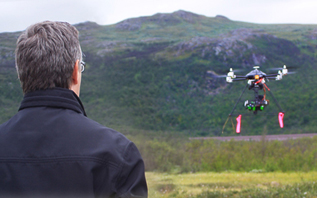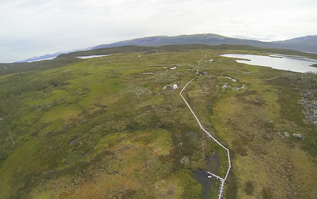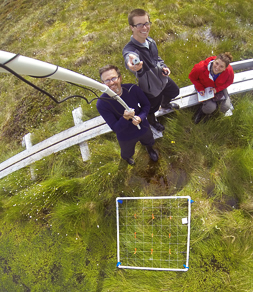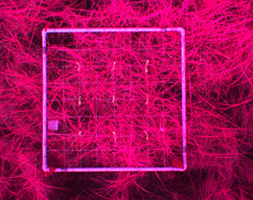Fall 2013
Earth Science
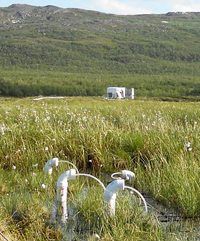 |
|
|
Acoustic hydrophone sensors in the Stordalen mire complex. Photo by Kaitlyn Steele, UNH. |
IN 2010, a chance encounter between Earth Systems Research Center scientists Ruth Varner and Michael Palace near the center's mailboxes led to a novel research project aimed at listening for methane gas bubbles in the hinterlands of Sweden.
The pilot project used tiny underwater hydrophones to hear the gas bubbling up through peat and from lakebeds—a process known as methane "ebullition." It was an effort to better quantify the powerful greenhouse gas's global budget, which is a big piece in the climate change puzzle.
The proof-of-concept work panned out and the unique methodology is now a core component of two Sweden-based climate change projects headed up by Varner—a National Science Foundation Research Experience for Undergraduates program and an NSF Macrosystems Biology project.
What's more, the latter, larger project incorporates another novel bit of technology initiated by Palace—a camera-toting "quadcopter" that hovers and snaps infrared images of the rapidly changing peatland. Palace et al also propose to use the copter to take thermal imagery that will help measure the shifting freeze-thaw cycle of lakes.
"We're really going all out with the Swedish work," says Palace who, in addition to being a tropical ecologist, is a sound technologist, musician and inveterate gadget guy. Palace incorporates technology into his scientific investigations whenever he can; it was he who was opening up a box of hydrophones he'd received in the mail when Varner happened by, had her interest piqued, and the rest is history.
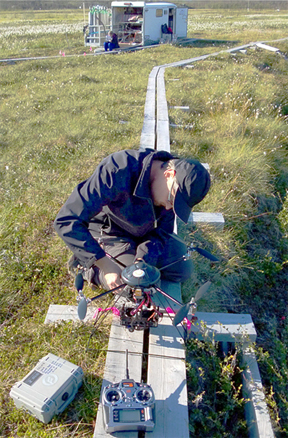 |
|
| Michael Palace readies the unmanned autonomous vehicle "quadcopter" for flight. Photo by Patrick Crill, Stockholm University. |
The shoebox-size, lightweight, four-propeller copter is being used for intermediate remote sensing of the changing Stordalen mire permafrost region some 124 miles north of the Arctic Circle. That is, the copter provides imagery from as high as 300 feet up and is bookended by ground-level shots and satellite imagery. Taken together, this provides the big picture.
Palace and his quadcopter are funded through the macrosystems grant, which began this past summer, while the undergraduate research project that initiated the Stordalen work concluded its second field season at summer's end.
Varner is director of the Northern Ecosystems Research for Undergraduates program that focuses on the impacts of climate change on ecosystems in Northern Sweden. NERU is a collaboration between UNH and the Abisko Scientific Research Station in Abisko, Sweden.
"We just finished our second season of the four-year Research Experience for Undergraduates grant, and this year expanded both the number of participating faculty and students," says Varner.
2012's inaugural NERU work involved nine undergraduates from universities and colleges around the country, including two from UNH, and served as an additional test-bed for the methane ebullition/hydrophone measurement technique. This past field season saw ten new undergraduates continuing the ebullition work and expanding into the macrosystems project that is focused on quantifying methane fluxes from different wetland ecosystems by means of various measurements, including the remote sensing via the quadcopter.
"There's a crossover between the two projects and the macrosystems grant was written with the intent of leveraging the student research to help address our larger research question," Varner notes. "The NSF likes that this isn't just 'made-up' projects for students, that it's authentic research cross-connected with the macrosystems grant, and that they're supporting other faculty to go to Abisko and jumpstarting other researchers."
Through the macrosystems grant, additional faculty and postdocs were brought on board this past field season to enhance both the research and the student mentoring that is part and parcel of the undergraduate work.
In addition to original UNH faculty members Julie Bryce (geochemistry), Serita Frey (soils), and Erik Hobbie (terrestrial ecology/fungi), the expertise of Palace, Joel Johnson (geology), and Maurice Crawford of Elizabeth City State University in North Carolina were added to the mix this summer.
Crawford's aquatic plant ecology adds a missing piece into the investigation of these northern wetland ecosystems, and his involvement could potentially help draw students from ECSU—an historically black college with which UNH has a formal research partnership—into next summer's field campaign.
Says Varner, "NSF supplemented the undergraduate research grant to include Maurice, who joined us for eight days to see the site, talk to students, and think about research opportunities for himself but also help me recruit Elizabeth City students for next year."
ECSU graduate Ryan Lawrence participated in last year's Abisko work and is now a master's student in the UNH Natural Resources and Earth Systems Science Ph.D. program. Varner is his advisor. Lawrence's previous undergraduate research experience used remote sensing techniques to analyze various aspects of the West Antarctic Ice Sheet.
"Working closely with Dr. Varner through the NERU program provided me with the opportunity to examine climate change from a hands-on perspective, and I became very interested in her research involving the measurement of greenhouse gas emissions from sub-Arctic peatlands," Lawrence says. "I chose to build upon that experience by attending UNH to learn more about the impacts of climate change on high northern latitude wetland ecosystems."
From the ground up
A UNH undergraduate participating for the first time this year was Samantha "Sam" Anderson, a rising senior who assisted Palace in characterizing and imaging plant species across the mire. In combination with on-the-ground measurements made by other faculty and students, the end goal of the work Palace and Anderson are doing is being able to predict emissions of methane and carbon dioxide across the landscape by analyzing remotely sensed imagery from the ground up.
In addition to the copter shots, Palace and Anderson mounted the same camera used on the copter—an Agricultural Digital Camera—on a 10-foot pole and took images of the vegetation in defined grids using the near-infrared, red, and green bands of the spectrum. These are the same bands used by the Earth-orbiting Landsat remote sensing satellite.
In a nutshell, this imagery provides a means to compare variations in texture by distinguishing the relation of one pixel value from the ones surrounding it. In tandem with other data, this can be used to estimate the relative emissions of gases from the various plant communities at various times of year in strictly defined plots.
The mire is a landscape that can change drastically over short distances—from hummock to hollow, from dry to wet—and thus species differences are likewise heterogeneous.
"There is so much diversity in the peatland that even in our little grids we might have twelve different species and each one of those stores and releases carbon dioxide and methane differently," says Anderson. "Depending on where you're located and what the environmental conditions are, just five feet can make a big difference in terms of how the gases are released or stored."
She adds, "So we needed to create this intermediate level using the pole-mounted camera and the copter to see small-scale changes. But we'd like to gradually go to a little higher scale, like a regional scale, and try to predict those fluxes because these wetlands used to be sinks, but now with the changing climate they may become sources."
Says Palace, "The next step is to plot our ground-based remote sensing with satellites, and we did fly the copter over a portion of the mire with a camera that mimics Landsat. This will be our scaling mechanism. So we go from field to localized remote sensing with the copter to satellite imagery, then take pictures in other areas and extrapolate across the landscape."
Palace also notes that both the copter and camera technology get better all the time, which similarly propels the research forward. "And our little research group is trying to actually be part of the horse that helps pull it along."
Helpful in that regard is the NSF undergraduate research program itself, which provides researchers with a bit more experimental elbowroom.
"We can do some interesting things that you might not be able to do in a traditional grant because you have flexibility to try new things with students," Varner says.
That is, the program is about giving students a research opportunity but is not necessarily tied to some specific outcome for that research. "So we're able to try some new techniques and pilot some ideas, like Mike being able to fly some cameras on a copter that might not have been funded until we had proven the technology," says Varner.
Of mentors and mentees
The addition of faculty and postdocs to this year's NERU work was not only intended to broaden the research but also to bolster the mentoring aspect of the program—a key part of the experience.
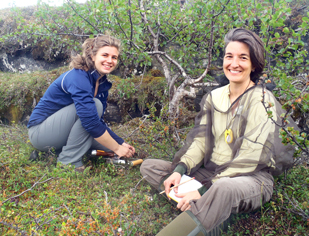 |
|
| Undergraduate Haley Dunleavy of Alaska Pacific University and UNH professor Serita Frey. Photo by Samantha Anderson, UNH. |
According to Varner, the students openly expressed appreciation for the time and care faculty and postdocs took with them as their research projects unfolded over ten weeks. The students also thrived on being active participants in a broad scientific community that included a host of international researchers at Abisko.
"When you get all these researchers as part of the group in a room with the students talking about their projects, the students really enjoy the scientific discussion that they don't typically have access to as an undergraduate taking classes with prescribed labs," says Varner. "With this research program I'm pushing our understanding of the ecosystem from scientists in different fields. We get excited about each other's questions and perspectives that we didn't necessarily think about, and I think the students enjoy watching that discussion."
Notes Sophie Burke, who went to Abisko during the inaugural year as a UNH senior and returned this year as a research assistant, another key aspect to the NERU experience is students being given the opportunity and freedom to explore research possibilities and be full participants in the science.
"Traditionally, I think much of the time undergraduates are told what to do and serve as technicians, in a sense, rather than being truly involved in the research. But in this program they were all able to come up with their own projects after broader group discussions and talk about their research with their mentors on equal footing. The mentors really value the students' perspectives and suggestions."
Evidence of the program's success will be visible at this year's annual American Geophysical Union Fall Meeting where more than two dozen abstracts written or co-written by the undergraduates will be available.
Says Varner, "This year has been amazing, the students were topnotch. You should never underestimate how much quality work an undergraduate can do and handle. Clearly you can do publishable research with undergraduates."
To meet the students and learn more about the Northern Ecosystems Research for Undergraduates program, visit http://neru.sr.unh.edu.
